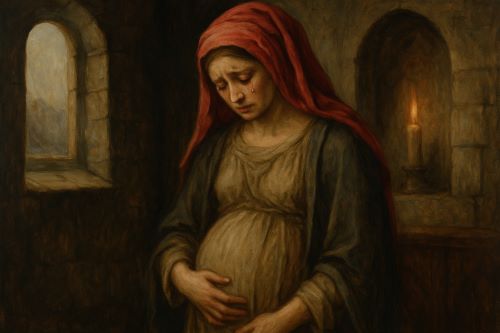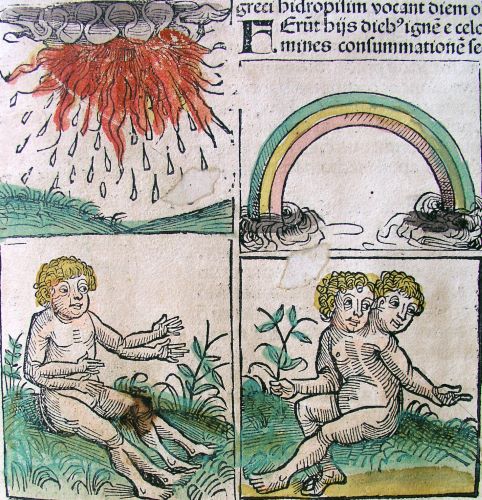

Women carved out spaces for ritual, healing, and survival — often in defiance of the systems that sought to define them.

By Matthew A. McIntosh
Public Historian
Brewminate
Introduction
The experience of miscarriage in the medieval world occupied a murky space between medicine, theology, and folklore. While not uncommon, the loss of a pregnancy before birth was shrouded in mystery and moral ambiguity. Women’s reproductive systems were poorly understood, yet closely monitored by male authorities — both medical and religious. Miscarriage thus became a site of fear, shame, divine judgment, and often silence. Here we explore the cultural meanings and responses to miscarriage in the medieval West by examining four key areas: medical theory, theological interpretations, social practices, and gendered blame. In doing so, it seeks to understand not just the act of miscarriage, but the world that formed around it — a world anxious about the fragility of life and the role of women in transmitting it.
Medieval Medical Thought and Miscarriage
Medieval medicine inherited much of its understanding of miscarriage from classical authorities such as Galen, Hippocrates, and later Arabic scholars like Avicenna. In these texts, miscarriage — often referred to as “abortion” regardless of cause — was defined as the expulsion of a fetus before it had achieved a “perfect” form.1 This definition was rooted in Aristotelian embryology, which proposed that the fetus became fully human only after ensoulment, typically believed to occur 40 days after conception for males and 80 days for females.2 Therefore, miscarriages that occurred before this period were considered biologically and spiritually incomplete — neither fully tragic nor fully innocent.
Treatments for preventing miscarriage reflected humoral theories of the body. A woman’s constitution was believed to be cold and moist, prone to imbalance, and miscarriage was often blamed on an excess of black bile, strong emotions, or immoderate physical activity.3 Midwives and physicians prescribed rest, dietary control, and various herbal remedies — though their success was speculative at best. Popular “medical” advice also included placing amulets or relics near the womb to ward off evil spirits, blending supernatural concerns with bodily care.
Scholars have noted that medieval medical texts often conflated intentional abortion and spontaneous miscarriage, especially in male-authored manuscripts.4 This conflation not only blurred the lines between criminality and tragedy but also suggested that the loss of a pregnancy was inherently suspect — an act potentially chosen, even when claimed as accidental. This ambiguity reflects both ignorance of reproductive biology and a broader cultural unease with female autonomy.
The lack of anatomical precision and reliance on inherited authority made miscarriage a medical mystery. Without clear understanding of gestation, medieval healers frequently turned to astrology, humoral charts, and divine will to explain pregnancy loss. What medicine could not predict or prevent, religion and superstition sought to control — often at the expense of women themselves.
Theology and the Soul in Lost Pregnancy

Christian theology in the medieval period offered a complex and often contradictory framework for understanding miscarriage. Central to the issue was the question of ensoulment: When did the soul enter the fetus? The dominant view, shaped by Augustine and later refined by scholastics like Thomas Aquinas, held that the soul entered the body only after the fetus had reached a certain stage of development.5 Thus, a miscarriage before this point — typically the first trimester — was not viewed as the loss of a fully ensouled human life.
This theological position had profound implications. While it may seem to lessen the emotional or moral burden of early miscarriage, it also rendered the lost fetus a kind of spiritual non-entity. No formal funeral rites were offered. The miscarried body was often buried discreetly, if at all, and prayers were directed toward the mother’s purification rather than the salvation of the unborn.6 In many monastic rules, the loss of a pregnancy was treated more as an interruption of bodily discipline than as a bereavement.
At the same time, the Church feared that miscarriages could result from demonic interference or divine punishment. Popular sermons and penitential manuals occasionally warned that women who miscarried might be reaping the consequences of lust, gluttony, or disobedience.7 Though these views were not universally applied, they introduced a moral shadow that lingered over involuntary pregnancy loss.
This theology also placed miscarried fetuses in a kind of limbo. The Church did not permit baptism for the unborn, which meant they could not enter heaven. Theologians debated whether unbaptized miscarried infants were consigned to hell, a “natural” limbo, or some intermediate state of unconscious rest.8 These metaphysical uncertainties reflected deeper anxieties: if salvation was unavailable to the most innocent, what hope was there for anyone?
Women’s Experience, Silence, and Ritual

While theological and medical discourse dominated official narratives, the lived experience of miscarriage for medieval women was often marked by silence. In a society where women’s reproductive labor defined much of their identity, the failure to carry a child to term could be devastating — personally and socially. Yet it was rarely documented in women’s own voices. We are left to reconstruct these experiences from indirect references in letters, penitentials, folk traditions, and healing practices.
Women sometimes sought consolation and explanation in pilgrimage. Shrines to the Virgin Mary, to saints like Margaret of Antioch (protector of pregnant women), or to local martyrs were often visited after a miscarriage, not just to pray for future fertility, but to process grief.9 These sacred spaces acted as informal mourning sites in a world where no official rites existed for the unborn. Pilgrimage allowed women to mourn publicly in a way that would otherwise have been socially inappropriate.
Domestic rituals, such as bathing in consecrated water, wearing relics, or lighting candles for fertility saints, also offered emotional scaffolding. Midwives and older female kin might participate in these rituals, forming a community of embodied knowledge that passed beneath the official registers of Church or state.10 While male authorities sought control, these women preserved continuity and care.
Yet there was also shame. In many cases, miscarrying women kept the event secret, fearing blame from husbands or in-laws. In aristocratic contexts, the stakes were even higher, as dynastic succession depended on successful childbirth.11 The absence of healthy offspring could alter inheritance, alliance, and political strategy. The emotional cost of miscarriage was thus compounded by structural pressures far beyond the womb.
Blame, Control, and the Burden of the Womb
In a world obsessed with reproduction yet bereft of reproductive science, miscarriage invited suspicion. Women who lost pregnancies might be accused — quietly or openly — of sin, negligence, or even sorcery. This was especially true in communities that lacked midwives or healers with strong reputations.12 In such places, miscarriage could provoke rumors of herbal poisoning or witchcraft, often with no distinction made between intentional and spontaneous loss.
Legal codes and ecclesiastical courts sometimes reinforced these suspicions. Though direct punishments for miscarriage were rare, cases did arise in which women were interrogated about their actions during pregnancy — their food, movements, or sexual behavior.13 Canon law increasingly blurred the lines between abortion and miscarriage, making any pregnancy loss a potential site of judgment. This control reflected a larger trend: the medicalization and moralization of women’s bodies under patriarchal logic.
Even in cases where blame was not legally pursued, cultural attitudes could be punishing. The expectation that women bear children — and that they do so successfully — meant that miscarriage represented not just a personal loss, but a failure to fulfill one’s gendered destiny.14 Men who failed in war might be redeemed; women who failed in childbirth often were not.
By the later Middle Ages, especially under the growing influence of scholastic theology and legal codification, these pressures became more pronounced. Female bodies were increasingly seen not as natural mysteries but as potential legal liabilities.15 Miscarriage thus came to signify not just the loss of a child, but the ever-tightening noose of patriarchal surveillance around the female body.
Conclusion: Bearing the Weight of Loss
Miscarriage in the medieval world was more than a medical event — it was a crucible of theology, gender, power, and grief. Whether seen as a punishment, a moral failure, or an unfortunate accident, pregnancy loss reverberated through multiple layers of medieval life. Medicine could not explain it, theology could not resolve it, and society often could not accept it without suspicion. And yet, in the shadows of these structures, women carved out spaces for ritual, healing, and survival — often in defiance of the systems that sought to define them.
Appendix
Endnotes
- Monica H. Green, Making Women’s Medicine Masculine: The Rise of Male Authority in Pre-Modern Gynaecology (Oxford: Oxford University Press, 2008), 109.
- Aristotle, Generation of Animals, trans. A.L. Peck (Cambridge, MA: Harvard University Press, 1942), II.1.
- Helen King, Hippocrates’ Woman: Reading the Female Body in Ancient Greece (London: Routledge, 1998), 53.
- Katharine Park, “The Rediscovery of the Clitoris: French Medicine and the Tribade, 1570–1620,” The Body in Parts, ed. D. Hillman and C. Mazzio (New York: Routledge, 1997), 171.
- Augustine, De anima et eius origine, 4.4.
- Caroline Walker Bynum, Holy Feast and Holy Fast: The Religious Significance of Food to Medieval Women (Berkeley: University of California Press, 1987), 200–202.
- John T. Noonan Jr., Contraception: A History of Its Treatment by the Catholic Theologians and Canonists (Cambridge, MA: Harvard University Press, 1986), 123.
- Peter Lombard, Sentences, Book II, Distinction 33.
- P. H. Cullum, “Pregnancy and Childbirth in the Middle Ages,” in Women and Religion in Medieval England (Woodbridge: Boydell Press, 1996), 101–02.
- Barbara Hanawalt, The Ties That Bound: Peasant Families in Medieval England (Oxford: Oxford University Press, 1986), 155.
- Judith Bennett, Women in the Medieval English Countryside (New York: Oxford University Press, 1987), 66.
- Michael D. Bailey, Magic and Superstition in Europe: A Concise History (Lanham, MD: Rowman & Littlefield, 2007), 75.
- Richard H. Helmholz, The Spirit of Classical Canon Law (Athens, GA: University of Georgia Press, 1996), 145.
- Mary Dockray-Miller, Motherhood and Mothering in Anglo-Saxon England (New York: Palgrave Macmillan, 2000), 44.
- Sara McDougall, Royal Bastards: The Birth of Illegitimacy, 800–1230 (Oxford: Oxford University Press, 2017), 101.
Bibliography
- Aristotle. Generation of Animals. Translated by A.L. Peck. Cambridge, MA: Harvard University Press, 1942.
- Bailey, Michael D. Magic and Superstition in Europe: A Concise History. Lanham, MD: Rowman & Littlefield, 2007.
- Bennett, Judith. Women in the Medieval English Countryside. New York: Oxford University Press, 1987.
- Bynum, Caroline Walker. Holy Feast and Holy Fast: The Religious Significance of Food to Medieval Women. Berkeley: University of California Press, 1987.
- Cullum, P. H. “Pregnancy and Childbirth in the Middle Ages.” In Women and Religion in Medieval England. Woodbridge: Boydell Press, 1996.
- Dockray-Miller, Mary. Motherhood and Mothering in Anglo-Saxon England. New York: Palgrave Macmillan, 2000.
- Green, Monica H. Making Women’s Medicine Masculine: The Rise of Male Authority in Pre-Modern Gynaecology. Oxford: Oxford University Press, 2008.
- Hanawalt, Barbara. The Ties That Bound: Peasant Families in Medieval England. Oxford: Oxford University Press, 1986.
- Helmholz, Richard H. The Spirit of Classical Canon Law. Athens, GA: University of Georgia Press, 1996.
- King, Helen. Hippocrates’ Woman: Reading the Female Body in Ancient Greece. London: Routledge, 1998.
- Lombard, Peter. Sentences. Book II.
- McDougall, Sara. Royal Bastards: The Birth of Illegitimacy, 800–1230. Oxford: Oxford University Press, 2017.
- Noonan, John T. Jr. Contraception: A History of Its Treatment by the Catholic Theologians and Canonists. Cambridge, MA: Harvard University Press, 1986.
- Park, Katharine. “The Rediscovery of the Clitoris.” In The Body in Parts, edited by D. Hillman and C. Mazzio, 171–193. New York: Routledge, 1997.
Originally published by Brewminate, 07.09.2025, under the terms of a Creative Commons Attribution-NonCommercial-NoDerivatives 4.0 International license.


